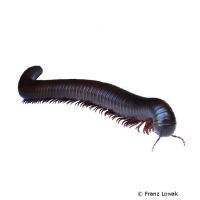Giant African Millipede (Archispirostreptus gigas)
| Giant African Millipede Archispirostreptus gigas | |
|---|---|
| Name | Giant African Millipede |
| Name Lat. | Archispirostreptus gigas |
| Family | Spirostreptid Millipedes |
| Family lat. | Spirostreptidae |
| Order | Millipedes |
| Order lat. | Spirostreptida |
| Origin | SE-Africa |
| Habitat | Forest, tree savanna |
| Diet | Dead wood, leaves, veggies, fruits |
| Humidity | 50-70 % |
| Behavior | Nocturnal, peaceful |
| Keeping | Individual, group |
| Care Level | Easy |
| Housing | Semi-humid terrarium |
| Breeding | Moderately difficult |
| Life Span | 5-10 years |
| Protection | No |
| Metric Units | |
| Size | 17-30 cm |
| Temperature Day | 22-29 °C |
| Temperature Night | 18-22 °C |
| Housing Size | 50 x 40 x 40 cm |
| US Units | |
| Size | 7"-12" |
| Temperature Day | 72-84 °F |
| Temperature Night | 64-72 °F |
| Housing Size | 20" x 15" x 15" |
Distribution and habitat
The range of the mainly crepuscular and nocturnal giant centipedes extends from Somalia and Tanzania to South Africa. They inhabit moist forests and tree savannahs with distinct dry and rainy seasons.
Maintenance
A terrarium with a minimum size of 50 x 40 x 40 cm (L x W x H) is recommended. The terrarium should be placed in a quiet place without sunlight.
You will need a 10-15 cm deep substrate, which should consist of a mixture of terrarium humus, foliage (oak), rotting plant material and small branches, enriched with lime (e.g. crushed cuttlefish or bird sand). It is recommended to add a drainage layer (e.g. gravel) to prevent the substrate from sinking. In addition, a shallow water dish, cork tubes and pieces of softwood branches stacked on the bottom, which also serve as hiding places and food. Rotten and eaten branches must be supplemented regularly. All substrate should be kept moist at all times. Daily, the inside of the terrarium should be finely sprayed with water (humidity), but a rain or mist system is better
| Temp. day: 22-29 °C | Temp. night: 18-22 °C | Humidity: 50-70 |
The soil temperature (no soil heating) should be constantly about 25 °C and the lighting duration should be 8-12 hours, depending on the season. Light sources that also produce the necessary heat are ideal.
Diet
They eat mainly rotting plant material (leaves and wood), supplemented with ripe fruit (especially banana), raw potato slices, lettuce and vegetables (e.g. zucchini pieces). The feed must be enriched (dusted) with a lime preparation or e.g. cuttlefish to build up the skin armor. To cover their protein needs, canned cat food, dried insects (e.g. crickets) and especially for young animals fish flake food should be offered occasionally
A varied diet promotes health and prevents deficiency symptoms.
Reproduction and breeding
The sexes can be distinguished by the 7th pair of legs, which are formed into gonopods in males.
The female lays her eggs (up to 700) in oothecae within about 4 weeks. At a temperature of 24-26 °C, the incubation period is 1-2 months. The larvae remain in the substrate until after the 2nd molt, where they feed on organic material before coming to the surface. They reach sexual maturity after 3-4 years.
Important
They can be used in any terrarium with appropriate climate as a cleaning column. They recycle food remains, keep the substrate loose and even eliminate mold!
They have a defensive secretion that kills bacteria and irritates the skin. Contact can cause skin discoloration and allergic reactions, such as painful blistering. Affected skin areas should be rinsed thoroughly with water immediately. Inhalation of the vapors should also be avoided. Wearing of gloves is recommended.
Animals should only be transported in well-ventilated containers filled with substrate, as they can poison themselves and each other in stressful situations.
Before purchase, a terrarium should be prepared that meets the species-specific needs. Good ventilation without drafts is necessary, as well as equipment for measuring temperature and humidity. The lighting has to correspond to the species-specific day-night rhythm and should be placed in such a way that the animals cannot injure themselves. The terrarium should be locked in such a way that neither unauthorized persons can open it nor the animals can escape. Special attention must be paid to thorough hygiene and impurities must be removed regularly.
Further literature can be found in your pet store.
References
Text: Serena Werle; Image: Franz Lowak
Source: HENKEL & SCHMIDT (2010): Taschenatlas Wirbellose für das Terrarium, Verlag Ulmer; ENGELMANN & LANGE (2011): Zootierhaltung - Tiere in menschlicher Obhut: Wirbellose, Harri Deutsch Verlag
